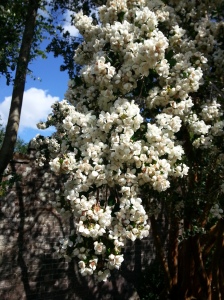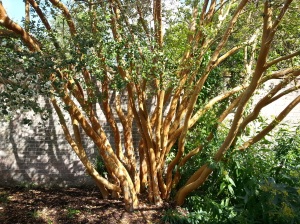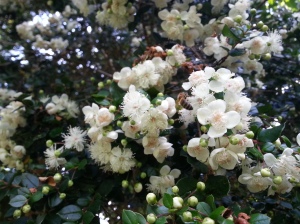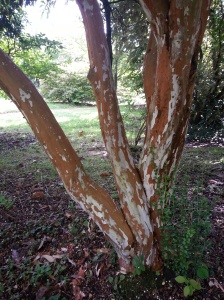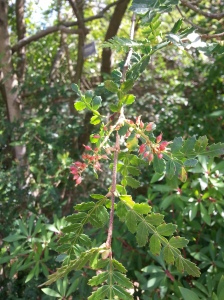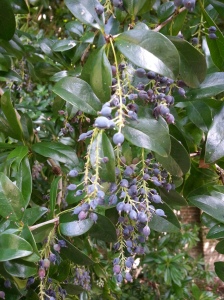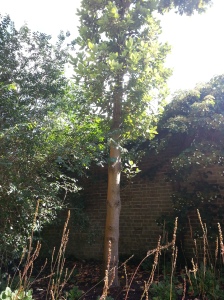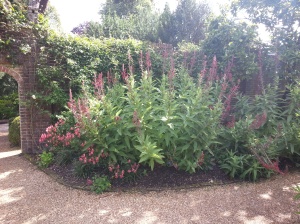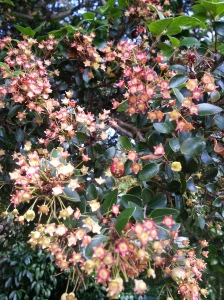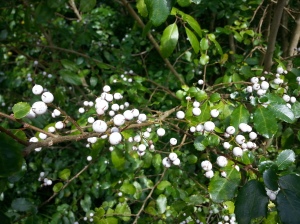
Acer + Hydrangea = Nymans in Autumn
Nymans is often referred to as a garden for all seasons, but for many of our vistors and indeed members of the garden team, Autumn is perhaps the favourite of them all. The showy blooms of Summer may well have faded into memory but the kaleidoscope of colour at this time of year never ceases to dazzle and excite. Whether it’s the fiery foliage tones or the beautiful fruits that adorn the trees that you’re after, Nymans should certainly be top of your list of places to visit soon. In this week’s blog we’ll take you through some of the highlights that await you…

The view from the formal gardens to the Arboretum

And here it is in some more detail
Perhaps the most obvious place to start looking for turning leaf colour is in our Arboretum and even if you can’t make the journey through there, you can still take most of it in from the Prospect look-out which the Messel family designed for just such a thing. The deeper you get into this part of the estate the more examples of leaf colour you’ll find but one of the feature trees there at the moment is this beauty:

Carya ovata
Also known as the Shagbark Hickory, the golden leaves on this tree are stunning…

…and they look just as attractive as their make their transition from green to yellow
Before we really get stuck in to some of the amazing Autumn leaf colour here at Nymans, it is worth taking a minute to find out why the leaves of trees all over the World turn from green to shades of yellow, orange and red each year. Plants make food to grow via photosynthesis, converting carbon dioxide and water into sugars using the energy in sunlight. This energy is captured by a green pigment in the leaves and stems of the plant, called chlorophyll. In Winter, with less sunlight, chlorophyll is not produced, but still remaining is the crucial chemical pigment behind leaves turning yellow – carotene. Also the main pigment in carrots, this yellow pigment is always present in the leaves but it isn’t visible until the production of chlorophyll slows in Autumn. Low temperatures also destroy chlorophyll so cold nights quicken the yellowing of leaves. As a tree prepares to shed its leaves in preparation for Winter, a layer of cells form across the base of each leaf stalk which restricts the movement of sugars back into the body of the tree. Concentrated in the leaf, sugars react with proteins in the cell sap to produce anthocyanin, a purply red pigment. It is the combination therefore of carotene and anthocyanain that produces the wonderful colours that we see on our trees every year.

Carotene is clearly the dominant pigment in the leaves of this Carya cordiformis (or Bitternut Hickory)…

..and it also looks absolutely stunning against the bright blue Sussex sky!
They say that a picture speaks a thousand words so it’s probably best if I shut up for a moment and let our foliage photographs do the talking! Click on any of the images in this blog for a bigger better view…

This Euonymus alatus (Winged Spindle bush) near the Prospect is covered in pinky purple leaves…

…while this Cornus controversa (aka the Wedding Cake Tree) at the other end of the garden near the entrance, is slowly turning a lovely orange colour

This Rhus typhina, also known as the Staghorn Sumac, can be found near the Quarry Pit and also has interesting furry stems

One of the classic trees for Autumn foliage colour is the Liquidambar styraciflua, or Sweet Gum tree

And this Parrotia persica, commonly known as the Persian Ironwood, isn’t too shabby either!

You can’t go too far wrong with an Acer tree when it comes to Autumn leaf colour. This Acer palmatum ‘Sango-kaku’ in the Pinetum for example, is one of the first to do its thing

Also in the Pinetum, this A. palmatum ‘Akegarsu’ has pure blood red leaves…

…while our ‘Bloodgood’ Acer adds red winged seed pods to the mix

In the Top Garden, this A. japonicum ‘Aconitifolium’, or Full Moon Acer, looks great no matter which angle you view it from!

Down in the Rock Garden meanwhile, A. palmatum Dissectum Group, in the right light looks like it might be on fire!

Enkianthus are another great group of plants to check out at this time of the year. Like most Acers, this E. perulatus from the Heather Garden is also native to Japan

While as the name suggests, Enkianthus chinensis hails from from another area of Asia!

Leaves don’t have to stay on their trees to look good either. This thick carpet of Acer and Tulip Tree leaves has an Autumnal charm of its own too
It’s not all just about the foliage however here in the Nymans gardens in the Autumn. After many of our plants have spent all Summer happily flowering away, if they’re pollinated, those flowers soon produce fruits and seed pods in a wide variety of shapes and colours. Perhaps not as easy to spot as a tree covered in brightly coloured leaves, these beautiful berries and fantastic fruits are well worth seeking out however. Here are some of the picks of the bunch…

This Sorbus ‘Leonard Messel’ is obviously a very important tree here at Nymans, as it is named after the son of the original owner Ludwig Messel. You can find it near the Prospect

Judging by the berries alone, you might think this is another Sorbus, or Mountain Ash. These pale yellow berries belong to our Stranvaesia davidiana ‘Fruto Luteo’ however. This is actually a type of Photinia and is sometimes referred to as the Christmas Berry. See if you can spot it along Winter Walk

If pink or yellow berries aren’t you’re thing, how about the orange fruits on this Cotoneaster franchetii var sternianus?

If you head to Holly Corner at the far end of the gardens you’ll see many varieties of holly. Some aren’t fruiting yet but this variegated Ilex aquifolium ‘Aurifodinia’ is clearly ahead of the game!

In the Top Garden behind the June Borders, you ‘ll find this Berberis wilsoniae shrub. Native to China, its berries are successionally turning from white…

…through coral pink…

…to a deep pink, almost red colour

Perhaps some of the more unusual Autumn fruit here at Nymans, these Euonymus grandiflorus f. salicifolius seed pods are very photogenic so make sure you bring your camera!
Anyone who read our blog from a couple of weeks ago on the Magnolia sargentiana var. robusta tree near the Tennis Lawn could be forgiven for thinking that perhaps that tree would win the award for most interesting Autumn fruit here at Nymans. Well, we think we might have found a contender for the crown and it’s another Magnolia:

Magnolia hypoleuca
What do you reckon? Also often called Magnolia obovata and commonly referred to as the Japanese Bigleaf or Japanese Whitebark, this tree is heavily associated with the Kurile Islands off Japan where it was first discovered. Earlier in the year you would have seen it covered in large creamy, scented flowers that can reach up to 20cm in diameter. Even at this time of the year though there are still plenty of other flowers to feast your eyes on here, as this last set of photos only goes to show…

Persicaria affinis ‘Superba’ combines pretty blooms with mesmerising leaf colour and is also a big hit with the bees too!

Surprisingly some of our Rhododendrons have decided to flower again, such as this rare R. cerasinum. Originally from Tibet, it was first described in 1931. We are obviously hoping that a second flowering this year won’t affect the blooms for next year

There is still time to catch these Hesperantha flowers in the Rock Garden…

…which is also where you’ll find this Daphne transatlantica bush

Autumn crocuses are also beginning to pop up everywhere…

…and as long as the frosts hold off you’ll still be able to see plenty of Salvias, Dahlias and Fuchsias like this ‘Voltaire’ variety which can be found near the Forecourt
Hopefully this little picture show has whetted your appetite to come and see the Autumn extravaganza here at Nymans for yourself very soon. As the weather appears to be staying mild for a while, now is the perfect time to snap a few pictures of your own too. Of course, there is plenty more to see and do here at all times of the year so to make sure you keep up to date with all that is going on at Nymans, don’t forget you can interact with us on both Twitter and Facebook as well as finding out all the important visitor information via our official website. If you want to be alerted by email when each new Nymans Garden Blog is published, simple click the ‘Follow’ button at the top of this page and carry out the instructions.








































